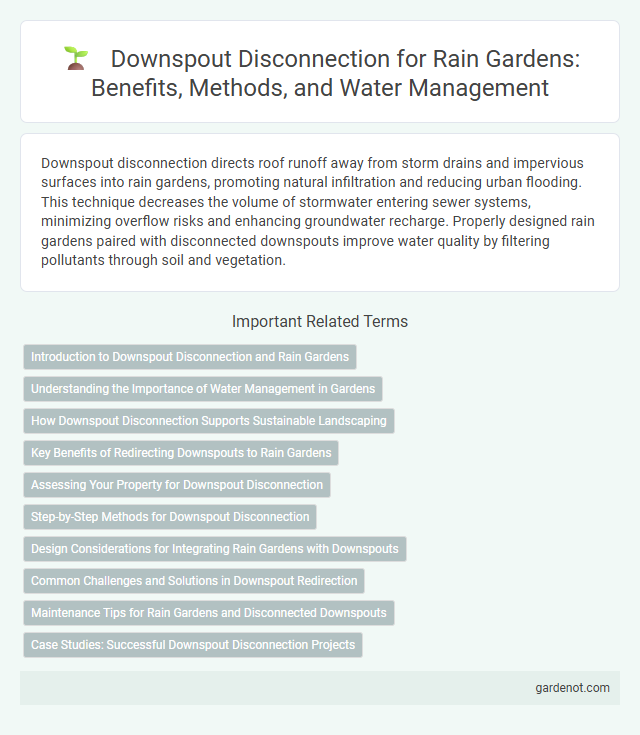Downspout disconnection directs roof runoff away from storm drains and impervious surfaces into rain gardens, promoting natural infiltration and reducing urban flooding. This technique decreases the volume of stormwater entering sewer systems, minimizing overflow risks and enhancing groundwater recharge. Properly designed rain gardens paired with disconnected downspouts improve water quality by filtering pollutants through soil and vegetation.
Introduction to Downspout Disconnection and Rain Gardens
Downspout disconnection involves redirecting roof runoff from traditional storm drains to rain gardens, enhancing onsite stormwater infiltration and reducing urban flooding. Rain gardens, designed with native plants and engineered soil, capture and filter runoff, promoting groundwater recharge and improving water quality. Integrating downspout disconnection with rain gardens supports sustainable urban water management and mitigates impacts of impervious surfaces.
Understanding the Importance of Water Management in Gardens
Downspout disconnection reduces stormwater runoff by redirecting rainwater from gutters into rain gardens, enhancing groundwater recharge and preventing erosion. Proper water management in gardens minimizes flooding risks and improves soil moisture levels, fostering healthier plant growth. Implementing downspout disconnection supports sustainable landscaping practices by promoting natural water infiltration and reducing pressure on municipal stormwater systems.
How Downspout Disconnection Supports Sustainable Landscaping
Downspout disconnection reduces stormwater runoff by redirecting roof water into rain gardens, promoting groundwater recharge and reducing pressure on municipal sewer systems. This sustainable landscaping practice minimizes erosion and water pollution by filtering runoff through vegetation and soil before it enters natural waterways. Implementing downspout disconnection enhances urban resilience by managing rainwater onsite and supporting biodiversity within green infrastructure.
Key Benefits of Redirecting Downspouts to Rain Gardens
Redirecting downspouts to rain gardens significantly reduces stormwater runoff by allowing water to infiltrate the soil naturally, decreasing the risk of flooding and erosion. It enhances groundwater recharge while filtering pollutants, which improves water quality in nearby streams and rivers. This sustainable practice also supports local biodiversity by creating habitats for native plants and beneficial insects.
Assessing Your Property for Downspout Disconnection
Assessing your property for downspout disconnection involves identifying locations where roof runoff can be diverted away from impervious surfaces to permeable areas such as rain gardens. Evaluate soil infiltration rates, slope, and proximity to foundations to ensure effective water absorption and prevent basement flooding. Properly disconnected downspouts reduce stormwater runoff, mitigate erosion, and promote groundwater recharge.
Step-by-Step Methods for Downspout Disconnection
Begin by assessing the existing downspout to determine the best disconnection point, typically near the foundation or at the gutter outlet. Use a saw or cutting tool to carefully detach the downspout, ensuring a clean edge for connection to the rain garden inlet. Install a splash block or a perforated pipe directing water into the rain garden, securing all joints with sealant or clamps to prevent leaks and erosion.
Design Considerations for Integrating Rain Gardens with Downspouts
Proper design of rain gardens for downspout disconnection requires evaluating soil permeability and slope to ensure effective water infiltration and prevent runoff. Positioning the rain garden at least 10 feet away from building foundations mitigates potential water damage while maximizing stormwater capture. Incorporating a pre-treatment area, such as a gravel bed or vegetated filter strip, enhances sediment removal before water enters the rain garden, protecting plant health and system longevity.
Common Challenges and Solutions in Downspout Redirection
Downspout disconnection often faces challenges such as soil erosion, improper water flow, and foundation damage when redirected into rain gardens without proper grading or inlet design. Solutions include installing splash blocks, ensuring gentle slopes away from structures, and incorporating gravel trenches or dry wells to promote effective infiltration and prevent water pooling. Periodic maintenance to clear debris and monitor soil saturation ensures long-term functionality of the redirected downspouts in rain garden systems.
Maintenance Tips for Rain Gardens and Disconnected Downspouts
Regular inspection of downspout disconnections ensures proper water flow into rain gardens, preventing erosion and soil compaction. Clearing debris from gutters and downspouts maintains optimal infiltration, enhancing the rain garden's effectiveness in stormwater management. Seasonal pruning of plants around downspouts supports unobstructed drainage and promotes healthy vegetation growth.
Case Studies: Successful Downspout Disconnection Projects
Case studies of successful downspout disconnection projects demonstrate significant reductions in stormwater runoff and improved groundwater recharge in urban areas. Projects in Seattle and Philadelphia show that redirecting downspouts to rain gardens can decrease combined sewer overflows by up to 30%. These initiatives utilize native plants and porous soils to enhance infiltration, reducing localized flooding and promoting biodiversity.
Downspout disconnection Infographic

 gardenot.com
gardenot.com